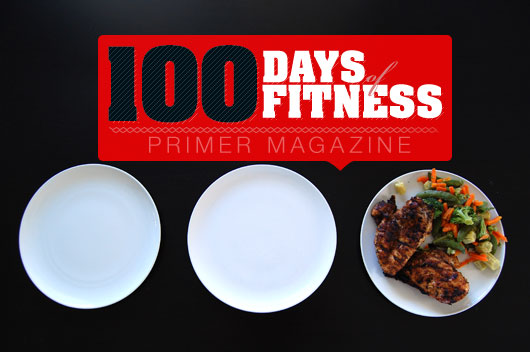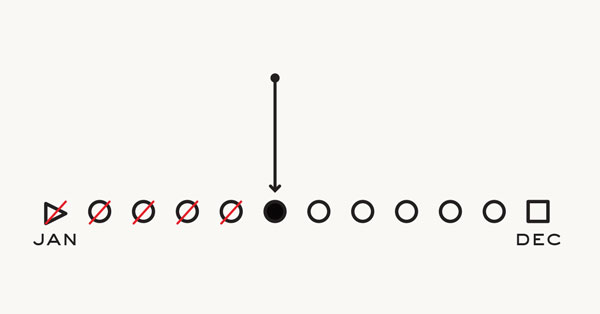100 Days of Fitness
- 100 Days of Fitness: An Introduction
- 100 Days of Fitness: Week 2 - Nutrition
- 100 Days of Fitness: Week 3 - Exercise
- 100 Days of Fitness: Week 4 - Building a Home Gym
- 100 Days of Fitness: Week 5 - Supplements
- 100 Days of Fitness: Week 6 - Expectations
- 100 Days of Fitness: Week 7 - Footwear
- 100 Days of Fitness: Week 8 - Food Lies
- 100 Days of Fitness: Week 9 - Meet the Kettlebell
- 100 Days of Fitness: Week 10 - Sample Circuits
- 100 Days of Fitness: Week 11 - Days vs Weeks
- 100 Days of Fitness: Week 12 – The Geography of Weight Loss
- 100 Days of Fitness: Week 13 - Travel Training
- 100 Days of Fitness: Week 14 – Meals, Snacks, & The Pocket Workout
- 100 Days of Fitness: Week 15 - What It's All About
- 100 Days of Fitness: Week 16 - Endless Push-Ups & Learning the Pull-Up
- 100 Days of Fitness: Week 17 – Adjustable Kettlebells + A Circuit
- 100 Days of Fitness: Week 18 – Intermittent Fasting & Strength Test
- 100 Days of Fitness: Week 19 – 15 Minute Workouts & A Cool Workout iPhone App + Contest
- 100 Days of Fitness: Week 20 - Switching It Up
- 100 Days of Fitness: Week 21 – Reflections
- 100 Days of Fitness: Week 22 – A Week Without a Workout
- 100 Days of Fitness: Week 23 – Why We Work Out & The 30 lbs Lost Marker
- 100 Days of Fitness: Week 24 - 5 Common Home Gym Mistakes
- 100 Days of Fitness: Week 25 – Work Ethic
- 100 Days of Fitness Special: Men's Health in Movember
- 100 Days of Fitness: The Muscle Aesthetic
- 100 Days of Fitness: The Cure for Holiday Pounds
There are no shortage of diets out there on the internet, ranging from sensible to insane. Perhaps you've tried a few of them. Maybe it was the “Soviet Air Force Diet” or the cabbage soup diet, or maybe someone even convinced you to drink nothing but maple syrup flavored water with lemon in it for three days. With so many utterly ridiculous diets out there, you should always think carefully before going forward with any diet that doesn't come to you from a certified nutritionist or food scientist or awesome dude like me.
Just kidding, take what I say with a grain of salt too. I've done my research and tested myself, but still – my experiences are anecdotal. I'm just being honest. You should do your research too when it comes to some of these more ‘out there' ideas.
All of that said, I want to talk about a diet that's gaining steam on the internet and has some science behind. Intermittent Fasting is a way of dieting where for extended periods of time, you don't consume food. Only water and possibly some diet drinks. This flies in the face of conventional dieting wisdom that tells you breakfast is the most important meal of the day and that you should eat six small meals a day instead of three ‘regular ones.'
Intermittent Fasting falls into two major camps – one fasts for at least a 24 hour period between one and three days a week. During the fasting days, you only consume water. On the off days, you eat normally. You'll probably eat a few hundred more calories than “normal” but because you effectively cut around 1700-2500 calories the day before, in the long run, you end up on a somewhat calorically restricted diet. The second diet includes “mini-fasts” every day, that generally range between 12 hours at a minimum and 16 hours at a maximum. Under this programs, you stop eating at say, 10pm, and then don't eat again until 2pm or 4pm, which would be 14-16 hours. Then you eat either one large meal (that can be as large as your total daily requirements) or two smaller meals, constrained to that 8-10 hour period.
These diets work in one of two ways. One, they can easily be tailored to low calorie diet standards. If you're only eating once or twice a day, it's hard to accidentally over eat or over snack. Eating six small meals a day means that you have to make sure each meal or snack is less than 400 calories. If you accidentally overeat at lunch and have a slightly bigger snack than normal, you can blow it. So on the calorie restriction facet of things, Intermittent Fasting can fit right in.
The second method is in how your body behaves when it's deprived for food for extended periods of times. The way your body reacts to sugars and carbs is radically different after a fast than it is if you're consistently eating through the day. As we talked about early in the 100 DoF program, carbs and sugars are linked to increased fatness in humans. By fasting you change the way your body reacts to carbs, limiting their impact on your glucose levels and your whole body. Or so the proponents say.
This may sound a bit crazy, though fasting diets are somewhat well-known and practiced throughout the world, from celebrities like Beyonce (who does a strange maple syrup water fast for two weeks at a time) to practitioners of Islam who fast during daylight hours for Ramadan. Many other religions also fast in varying ways at different times of the year, and none of them are dropping dead from starvation.
I'm going to guinea pig this for our Primer readers, and for myself. What I like about the idea behind it is that if you restrict yourself to only eating during certain hours, it's a nice, solid set of rules that you can't break. It also lets you eat bigger, more fulfilling meals during the day. You could snack on broccoli and almonds and chicken breast all day, or you could restrict yourself through the morning and then have a big helping of chicken or beef and a big pile of vegetables. That sounds better to me! Also, some proponents of fasting say that because your body is responding differently to sugars, you can be more lenient with your carbs. We'll see. Stay tuned to see how a week of intermittent fasting works for me.
My Results + Strength Test
On the scale Saturday morning I weighed in at 228lbs, down a pound from last week with 23.5lbs of total weight loss. This slow loss is part of what's motivating me to change my diet a little bit. I've also plateaued around 230lbs most of my life, and I want to break through that and get lower and charge through these last pounds.
As a way of measuring my strength, I returned to the gym today. A lot of people lose strength when losing weight as they'll lose some muscle too. Since I primarily do body weight workouts (tons of push-ups and pull-ups) and work with a kettlebell, I wanted to see how my strength would translate back to heavyweights and dumbbells. I jumped into the squat rack with 135lbs and busted through a warm-up set. Then I upped to 225lbs and did two working sets of 10 reps. I finished out with two sets of 275lbs. I wasn't going for any records here, but was definitely squatting numbers that positively compared to my previous values.
The big test came on the bench press. At my weakest, years ago, I struggled with 135lbs. At my strongest, I bench pressed 350lbs, though I was fairly heavy then. Around the start of the 100 DoF program, I was working with 225lbs and reps of ten. I could do some work up around 275lbs but I hadn't pushed myself in awhile. So today I wanted to find out if I could at least do as well as I did then.
I started with 135lbs to warm up and stretch. 10 reps, no problem. I jumped right up to 225lbs and did 10 reps. It felt good. Fairly heavy, but I knew I was strong enough to do more and probably around where I was. I tossed on a pair of 25lb plates and pressed 275lbs eight times. Next came a pair of 10s bringing it to 295lbs. I did this four times. Then added a pair of 5s, bringing the total to 305lbs. I pressed this once. I felt good and strong and new I could hit more. I stripped off the smaller weights and added more 45s. This brought the weight to 315lbs, each side of the bar loaded with three 45lb plates. I settled under, pressed it up, brought it down, and sent it right back up. Yes, it was heavy, but I did it completely unassisted.
I didn't want to push further without a spotter to keep me safe, so that's where I stopped for the day. I was confident in my abilities and know my body well enough that I can toy with weights out towards my one repetition maximum, but if you're pretty new to lifting, you definitely don't want to push yourself to your limits without a helper nearby.
Strength test completed though! And I felt great. I was definitely stronger than I was at the beginning of the 100 DoF program and my lifts were approaching my personal highs. To me, this proves that working out at home with the right equipment and the right intensity can develop strength and help bring you back to your old form.
So don't feel the need to join a gym, like I've been saying. You can build a great body at home. That said, I did enjoy lifting heavy weights again, so I personally might incorporate this more into my program.
















